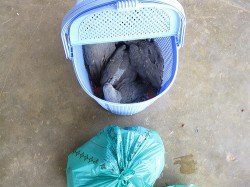Parrots can — and do — live longer than any other companion animal.* Unfortunately, their lives are not always the best and, like yours or mine, can be fraught with hurtful experiences. The birds who are now in their thirties and forties (and above) perhaps even moreso, because they were very likely wild-caught birds, pulled from their trees and forests and ultimately caged in a human home, never again to fly free. They have been condemned to a life sentence in captivity within a human environment.
The Wild Bird Conservation Act (WBCA) of 1992 banned the importation into the United States of the majority of wild-caught birds. While birds are still smuggled into the US and Canada, most birds after 1992 come from breeding programs within North America. Other countries have no such act in place, and wild-caught birds are still (in staggering numbers) pulled from their forest and jungle homes daily.
Parrots obtained prior to 1992 (arguably) went into homes where the knowledge of what we are now finally learning about providing care to parrots was non-existent. Even with the best of intentions, birds were fed seed diets, were relegated to tiny cages, and had humans who had no idea about the needs of these wild creatures they brought into their homes. Fortunately for parrots today there is a growing awareness of what a parrot needs, but that wasn’t always the case and this understanding is still in its infancy. With their wild natures, parrots were (and are) often neglected and perhaps even abused simply for being exactly what they are: wild animals.
If you are thinking about bringing a parrot into your home, please consider adopting an older bird. You may very well be the first home where it experiences the love, respect and understanding it deserves.
Here is the story of one such parrot. Iko was a 40ish year old Congo African Grey parrot (due to her history, her age can only be estimated). Shari Mirojnick, Iko’s final guardian, shares Iko’s story:
I got her from someone who had gotten her from a woman who was a junk hoarder. She only had her for 3 months when she realized she was allergic to her. The hoarder had her for 20 years, and had gotten her from an aunt that died.
I was told that she walked with a limp because the hoarder tried trimming her nails when she was drunk and lopped off part of Iko’s toe. It’s horrible just to think about, but I knew that wasn’t the reason why should walked with a limp. Turns out she had all kinds of old injuries, mostly on her right side. She had a badly-healed broken ankle that was completely arthritic; a permanently dislocated hip; broken vertebrae in the tail-end of her spine. She also had arthritic knees.
At the time I rescued her, we had seen an Amazon that had been thrown up against a wall [note: Shari is an avian veterinarian technician]. Apparently, not the first time the guy had done it, but that time he paralyzed the bird, and a customer took it in. It made me think that this had possibly happened to Iko.
The irony is, she was the nicest parrot I ever knew. I think she may have had some brain trauma, because she was just so sweet, trusting, and, um, a little slow. Her name was Rainbow, and had been a “he” the whole time. I knew she was a female, but had her sexed.
She had seen the vet for whom I work about nine months before I took her in, and she had been treated for gout. When I got her, she had klebsiella and pasturella infections, which cleared up. I decided to change her name to start her new life, and named her after the Ikodi people in Nigeria.
She died two years ago. Because her balance was so bad, she always fell, and she would pull out her broken tail feathers. She did this so much, and I guess for a looooong time, the feathers kept becoming impacted. It was causing her pain and discomfort, so she stayed in hospital for a long time getting her butt “buttered.” We were putting on antibiotic cream to keep it soft, and it was working. She was also getting fluids, and I think this caused her knees to weaken even more. She had to use her beak like a cane to get around. After several days home, I came home from work to find her a bloody mess, and fallen over. I rushed her back, and instead of putting her back in hospital, with lots more fluids, I decided to let her go.
*The average life span for a parrot in captivity can be much shorter than his potential life span. This is likely due to improper diet and lack of veterinary care. Approximate lifespans for various species are as follows:
Budgies: 15 – 18 years
Cockatiels: 15 – 30 years
Lovebirds: 10 – 20 years
Conures: 15 – 40 years
Amazons: 20 – 50+ years
African Greys: 25 – 50 years
Cockatoos: 30 – 50+ years
Macaws: 30 – 50+ years
Further information about parrot lifespans:
- Survival on the ark: life-history trends in captive parrots (scientific paper)
- The lifespan of some common pet birds
- Longevity in captivity
- Parrots’ average lifespans
- Diet influences lifespan in parrots (scientific paper, PDF)






2 Responses to Iko’s 40 years